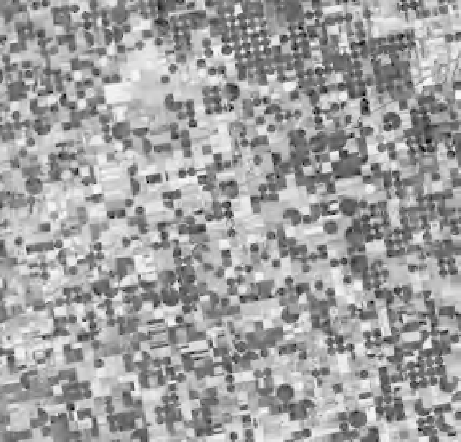Environmental Engineering Reference
In-Depth Information
Picture 9.1
Center-pivot irrigation systems that are 800 and 1,600 meters in diameter that use water from
the High Plains (Ogallala) Aquifer. The image was acquired on June 24, 2001, over Finney County in south-
western Kansas, is centered near 37.4 degrees north and 100.90 degrees west, and covers an area of
37.2 x 38.8 km.
Courtesy NASA/GSFC/METI/ERSDAC/JAROS, and U.S./Japan ASTER Science Team.
The Great Artesian Basin in Australia covers an area of 1.7 million square kilometers
(almost a fifth of the Australian continent), and the thickness of the combined layers varies
between 100 meters at the boundaries to 3000 meters in the deeper parts (“The Great
Artesian Basin,” 2006).
For water to move in aquifers, pores and fractures need to be connected and the porosity
determines the speed at which water moves. Highly permeable rocks have a network of
interconnected spaces that are large in number and size, which makes water move faster.
The direction in which water moves in aquifers is affected by level and pressure; water
moves from high to low levels and from high to low pressures at a speed that depends
largely on the permeability of the rock. High permeability is a good attribute in an aquifer
because water flows fast to the well and makes the well more productive. A second attribute
of a good aquifer is how easy the aquifer is recharged. Higher rates of recharge allow higher
well productivities.
Surface water
Surface water is water that collects on the surface of the Earth as streams, wetlands, lakes,
reservoirs, rivers, estuaries, seas, and oceans. In a broader sense, water locked in glaciers,
icecaps, and permanent snow is also considered surface water.
Surface water is restocked by the hydrologic cycle through precipitation (rain or snow) and
lost via evaporation and seepage into the ground, which eventually recharges aquifers.
All surface freshwater in the form of lakes, streams, reservoirs, wetlands, and the underly-
ing groundwater are part of watersheds. A watershed is an area of land that collects water from
rain and snow that follows a gradient toward its lowest part. Watersheds are topographically





